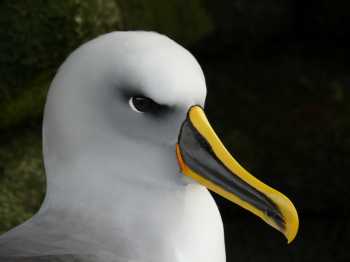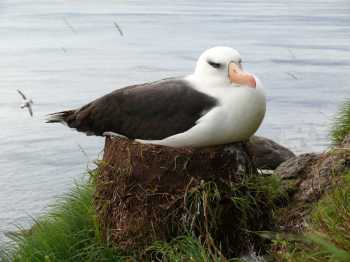It is clear that some individual albatrosses can live for many decades. Previous news items on this web site have highlighted two “60-plussers”, Wisdom the Laysan Albatross Phoebetria immutabilis (still with us) and the late Grandma, a Northern Royal Albatross Diomedea epomophora, as well as a 54-year old Grey-headed Albatross Thalassarche chrysostoma from the South Atlantic (click here).
Paul Sagar, Group Manager: Marine at the National Institute of Water and Atmospheric Research (NIWA) reports this week to ACAP Latest News on some more elderly albatrosses of three species which are now in their 40s, this time from New Zealand. His accounts follow.
Buller’s Albatross Thalassarche bulleri: 40 years
“Don and Carol Horning spent 13 months continuously on The Snares from December 1971 to January 1973. During this time Carol made daily visits to the Mollymawk Bay study colony during critical periods of the breeding cycle – first arrival of adults, laying, hatching, guard-stage and fledging – and this is still the only season in which the entire breeding cycle has been studied continuously from pre-egg to fledging. Our many subsequent trips have ranged in duration from a few days to four months each. In August 1972 Don and Carol Horning banded 859 Buller’s Albatross chicks near to fledging at many colonies (not just the Mollymawk Bay study colony) on The Snares and these were the first known-age birds of this species to be banded. The first of these birds to return to The Snares, as pre-breeders, were recaptured at the Mollymawk Bay study colony during 1977. Subsequently about 115 of these known-age birds have been recaptured, the latest in April 2012 as breeding birds. The next check of the study colonies of Buller’s Albatrosses at The Snares is planned for April 2013 and I’m hoping to find that some of these known-age birds are still alive and breeding.”

Buller's Albatross, The Snares, April 2007. Photograph by Paul Sagar
Campbell Albatross Thalassarche impavida: 44 years
“From at least 1960 to 1995 staff from the meteorological station on Campbell Island banded chicks annually at colonies in the vicinity of Bull Rock. Many of the 25 000 or so of these known-age birds are still alive and breeding. In November 2012 the oldest recorded in the Bull Rock study colony being birds banded in January 1968.”

Campbell Albatross, Campbell Island, October 2010. Photograph by paul Sagar
Grey-headed Albatross Thalassarche chrysostoma: 43 years
“From at least 1960 to 1995 staff from the meteorological station on Campbell Island banded chicks annually at colonies in the vicinity of Bull Rock. Many of the 7500 or so of these known-age birds are still alive and breeding. In November 2012 the oldest recorded in the Bull Rock study colony being birds banded in April 1969.”
To add to the above records the oldest-known Wandering Albatross D. exulans found at South Africa’s Prince Edward Islands in the southern Indian Ocean to date was an estimated 46-51 years old, the uncertainty being due to it not being originally banded as a chick. Some Wandering Albatrosses at the French Crozet Islands and at Bird Island in the South Atlantic are also reported as having reached ages of 50 years or more.
We now await news of the first “seventy-plusser”.
With thanks to Paul Sagar for information and photographs.
Reference:
Cooper, J., Battam, H., Loves, C. Milburn, P.J. & Smith, L.E. 2003. The oldest known banded Wandering Albatross Diomedea exulans at the Prince Edward Islands. African Journal of Marine Science 25: 525-527.
John Cooper, ACAP Information Officer, 20 February 2013

 English
English  Français
Français  Español
Español